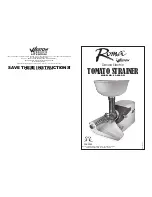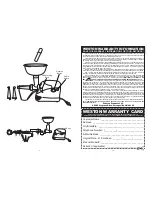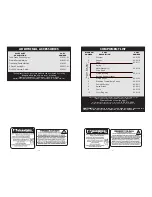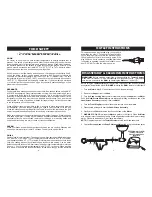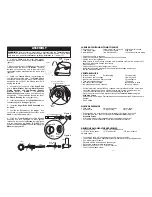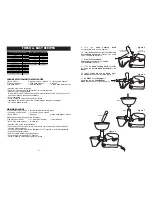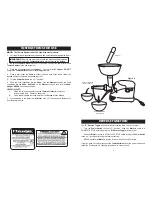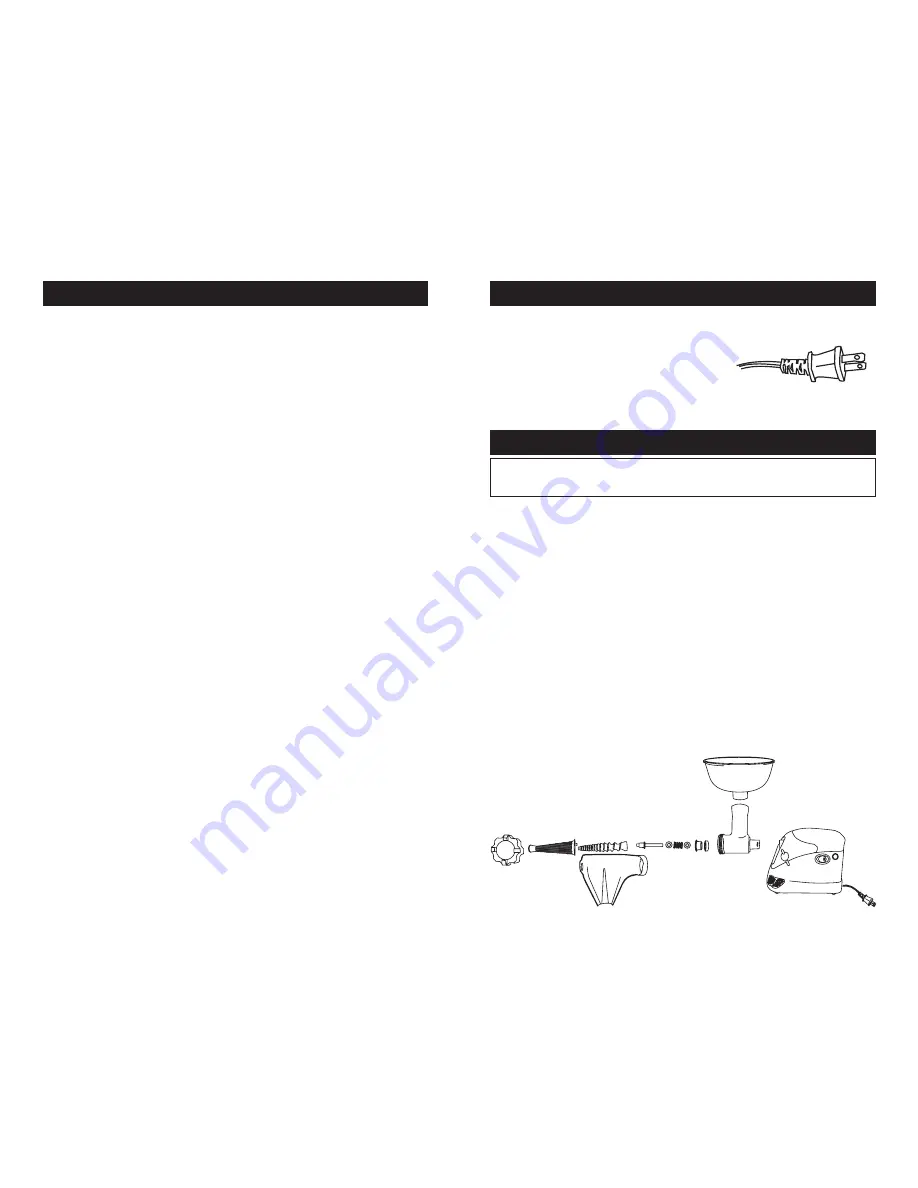
-5-
-12-
DISASSEMBLY & CLEANING INSTRUCTIONS
OUTLET INSTRUCTIONS
This appliance has a polarized plug (one prong is
wider than the other). To reduce the risk of electric
shock, the plug must fully fit into the electrical outlet.
If the plug does not fit, turn it over and try again. If the
plug still does not fit, contact a qualified electrician
in regards to updating the electrical outlets in your
home. DO NOT modify the plug in any way.
WARNING!
Before cleaning, assembling or disassembling the
Tomato Strainer
,
make sure it is turned off “O” and disconnected from the power source. Test to make
sure there is no power to the
Motor
by switching the
Motor
on “-” and off “O”.
Before using the
Tomato Strainer
for the first time, thoroughly clean all parts (including
accessories) as instructed below.
DO NOT
immerse the
Motor
in water or other liquid.
1. Turn the
Motor Unit
off “O” and disconnect it from the power supply.
2. Remove the
Hopper
from the
Head
.
3. Turn the
Head Locking Nut
counter-clockwise to loosen the
Head
from the
Motor
.
Push the
Head/Screen Assembly
forward slightly while lifting out the back end of the
Head/Screen Assembly
removing it from the
Motor
.
4. Turn the
Front Ring Nut
counter-clockwise to remove it from the
Head
.
5. Disassemble all the parts from the
Head/Screen Assembly
.
6. Gently turn the
Chute
clockwise to unhook the tabs on the
Motor
.
7.
WARNING!
DO NOT
immerse the
Motor
in water or other liquid. Clean the
Motor
with a damp cloth or towel then wipe dry. Wash all parts that contact food in warm soapy
water. Rinse with clean water. Dry all parts immediately.
NOTE!
Only plastic parts of the
Tomato Strainer
are top-rack dishwasher safe.
8. Coat the
Screens
,
Head
and
Drive Shaft Assembly
with a food-grade silicone spray.
There are basic rules to follow when handling food.
They are
COOK, SEPARATE, CLEAN,
and
CHILL.
COOK
It’s crucial to cook food to a safe internal temperature to destroy bacteria that is
present. The safety of hamburgers and other foods made with ground meat has
been receiving a lot of attention lately, and with good reason. When meat is ground,
the bacteria present on the surface is mixed throughout the ground mixture. If this
ground meat is not cooked to at least 160
o
F to 165
o
F (71
o
C to 74
o
C), bacteria will not
be destroyed and there’s a good chance you will get sick.
Solid pieces of meat like steaks and chops don’t have dangerous bacteria like E.
coli on the inside, so they can be served more rare. Still, any beef cut should be
cooked to an internal temperature of at least 145
o
F (63
o
C) (medium rare). The safe
temperature for poultry is 180
o
F (82
o
C) and solid cuts of pork should be cooked to
160
o
F (71
o
C). Eggs should be thoroughly cooked too. If you are making a meringue
or other recipe that uses uncooked eggs, buy specially pasteurized eggs or use
prepared meringue powder.
SEPARATE
Foods that will be eaten uncooked and foods that will be cooked before eating MUST
ALWAYS be separated. Cross-contamination occurs when raw meats or eggs come
in contact with foods that will be eaten uncooked. This is a major source of food
poisoning. Always double-wrap raw meats and place them on the lowest shelf in the
refrigerator so there is no way juices can drip onto fresh produce. Then use the raw
meats within 1-2 days of purchase, or freeze for longer storage. Defrost frozen meats
in the refrigerator, not on the counter.
When grilling or cooking raw meats or fish, make sure to place the cooked meat on
a clean platter. Don’t use the same platter you used to carry the food out to the grill.
Wash the utensils used in grilling after the food is turned for the last time on the grill,
as well as spatulas and spoons used for stir-frying or turning meat as it cooks.
Make sure to wash your hands after handling raw meats or raw eggs. Washing hands
with soap and water, or using a pre-moistened antibacterial towelette is absolutely
necessary after you have touched raw meat or raw eggs. Not washing hands and
surfaces while cooking is a major cause of cross-contamination.
CLEAN
Wash your hands and work surfaces frequently when you are cooking. Washing with
soap and warm water for at least 15 seconds, then dry with a paper towel.
CHILL
Chilling food is very important. The danger zone where bacteria multiply is between
40
o
F and 140
o
F (4
o
C and 6
o
C). Your refrigerator should be set to 40
o
F (4
o
C) or below;
your freezer should be 0
o
F (-17
o
C) or below. Simple rule: serve hot foods hot, cold foods
cold. Use chafing dishes or hot plates to keep food hot while serving. Use ice water
baths to keep cold foods cold. Never let any food sit at room temperature for more than
2 hours - 1 hour if the ambient temperature is 90
o
F (32
o
C) or above. When packing
for a picnic, make sure the foods are already chilled when they go into the insulated
FOOD SAFETY
NEVER immerse the Motor
in water or other liquid.
Clean it by wiping with a
damp cloth.

